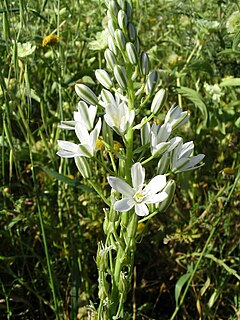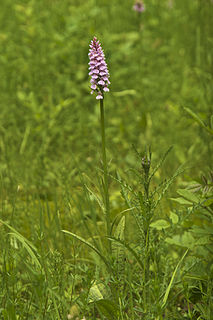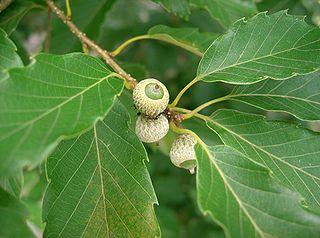
Ornithogalum narbonense, common names Narbonne star-of-Bethlehem, pyramidal star-of-Bethlehem and southern star-of-Bethlehem, is a herbaceous perennial flowering plant with underground bulbs, belonging to the genus Ornithogalum of the family Asparagaceae. The Latin name Ornithogalum of the genus, meaning "bird's milk", derives from the Greek, while the species name narbonense refers to the French town of Narbonne.

Gagea lutea, known as the yellow star-of-Bethlehem, is a Eurasian flowering plant species in the family Liliaceae. It is widespread in central Europe with scattered populations in Great Britain, Spain, and Norway to Siberia and Japan.

Maianthemum trifolium is a species of flowering plant that is native to Canada and the northeastern United States, from Yukon and British Columbia east to Newfoundland and south to Delaware.
Amaranthus wrightii is a species of flowering plant. It goes by the common name of Wright's amaranth. It occurs from western Texas into southern Arizona and as far north as Colorado at elevations between 500–2,000 m (1,600–6,600 ft).

Pulmonaria longifolia, is a semi-evergreen clump-forming herbaceous perennial plant, native to western Europe, including Britain, France, Spain, Portugal. It grows in semi-shaded habitats, such as woodland and scrub, to 2000 m above sea level.

Hemerocallis fulva, the orange day-lily, tawny daylily, corn lily, tiger daylily, fulvous daylily or ditch lily, is a species of daylily native to Asia. It is very widely grown as an ornamental plant in temperate climates for its showy flowers and ease of cultivation. It is not a true lily in the genus Lilium, but gets its name from the superficial similarity of its flowers to Lilium and from the fact that each flower lasts only one day.

Ornithogalum umbellatum, the garden star-of-Bethlehem, grass lily, nap-at-noon, or eleven-o'clock lady, a species of the genus Ornithogalum, is a perennial bulbous flowering plant in the asparagus family (Asparagaceae). O. umbellatum is a relatively short plant, occurring in tufts of basal linear leaves, producing conspicuous white flowers, in a stellate pattern, in mid to late spring. The flowers open late in the day, but when closed have a green stripe on the outside. It is native throughout most of southern and central Europe, and north-western Africa. O. umbellatum is often grown as a garden ornamental, but in North America and other areas it has escaped cultivation and can be found in many areas, where it may become an invasive noxious weed. Parts of the plant are considered poisonous, but are used in some regional cuisines. Essences are also sold as patent remedies. O. umbellatum has been depicted in art by artists such as Leonardo da Vinci, and folklore has suggested it originally grew from fragments of the star of Bethlehem, hence its horticultural name.

Hemerocallis middendorffii, known as Amur daylily, is a plant species in the subfamily Hemerocallidoideae of the family Asphodelaceae of the order Asparagales. It is native to the Russian Far East, northwest China, Korea, and Japan. It grows in meadows, mountain slopes, open woods, and scrub. It is cultivated in Asia for its edible flowers.

Gossypium arboreum, commonly called tree cotton, is a species of cotton native to India, Pakistan and other tropical and subtropical regions of the Old World. There is evidence of its cultivation as long ago as the Harappan civilization of the Indus Valley for the production of cotton textiles. This species of cotton was also introduced into East Africa and was grown by the Meroe civilization in Nubia. The shrub was included in Linnaeus's Species Plantarum published in 1753. The holotype was also supplied by him, which is now in the Linnean Herbarium in the Swedish Museum of Natural History. It is a sister species of Gossypium herbaceum.

Dactylorhiza maculata, known as the heath spotted-orchid or moorland spotted orchid, is an herbaceous perennial plant of the family Orchidaceae. It is widespread in mountainous regions across much of Europe from Portugal and Iceland east to Russia. It is also found in Algeria, Morocco, and western Siberia.

Ornithogalum nutans, known as drooping star-of-Bethlehem, is a species of flowering plant in the family Asparagaceae, native to Europe and South West Asia. It is a bulbous perennial growing to 20–60 cm (8–24 in) tall by 5 cm (2 in) wide, with strap-shaped leaves and green striped, pendent grey-white flowers in spring. It is cultivated, and has naturalized, outside its native range, for example in North America. It has become extremely invasive along the Chesapeake and Ohio Canal in Maryland. At least in North America, it is not as common as Ornithogalum umbellatum.

Allium tuolumnense is a rare species of wild onion, known by the common name Rawhide Hill onion.

Allium cratericola is a species of wild onion known by the common name Cascade onion. It is endemic to California, where is an uncommon member of the flora in several of the state's mountain ranges, including the northern and southern California Coast Ranges, the western Transverse Ranges, Klamath Mountains, and the Sierra Nevada foothills. Its range covers much of the state, from Riverside County to Siskiyou County.

Halothamnus lancifolius is a species of the plant genus Halothamnus, that belongs to the subfamily Salsoloideae within the family Amaranthaceae,. It occurs in Southwest Asia.

Lomatia ferruginea, commonly known as fuinque, is a small evergreen tree in the family Proteaceae.

Quercus serrata, the jolcham oak, (Chinese: 枹栎; pinyin: bāolì, 小楢 is an East Asian species of tree in the beech family. It is native to China, Taiwan, Japan, and Korea.
Iris ivanovae is a plant species in the genus Iris, it is also in the subgenus Iris and in the section Pseudoregelia. It is a rhizomatous perennial, from eastern Russia, China, and Mongolia.
Iris cedreti is a species of flowering plant in the genus Iris; it is also in the subgenus of Iris. It is a rhizomatous perennial endemic to Lebanon. It has long narrow leaves, short stem, and flowers with a white background which is covered with very small dots or veins of dark maroon, purple, purplish-maroon, or almost black. It has a dark maroon signal patch with a brownish or purplish beard. It is rarely cultivated as an ornamental plant in temperate regions, as it needs very dry conditions during the summer. It is listed as critically endangered by the IUCN.
Myopordon pulchellum is a species of flowering plants in the thistle tribe within the sunflower family.

Astragalus cedreti is a species of flowering plant in the legume family. It is a perennial plant with alternating, smooth pinnate leaves and red flowers. It blooms in June.
















